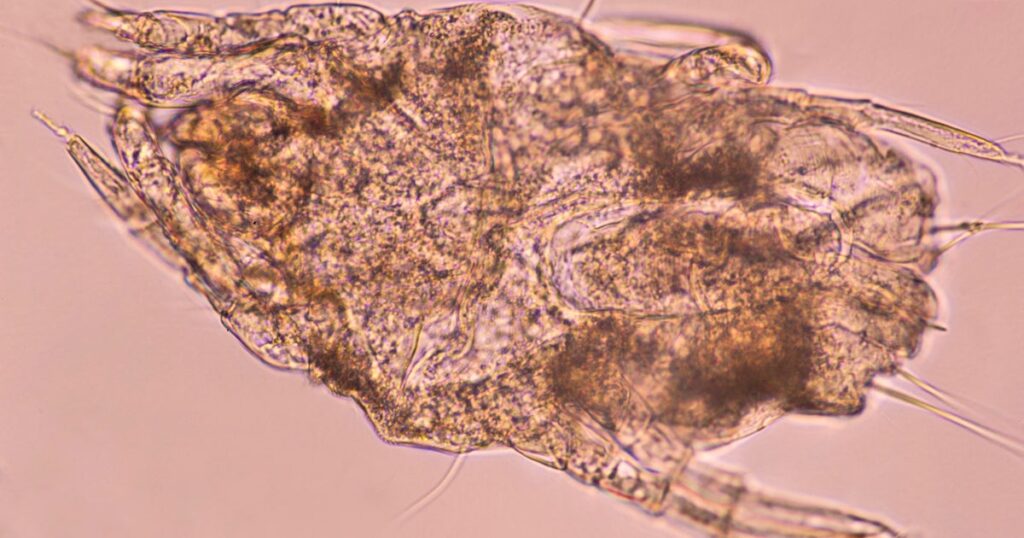Hiding behind your curtains, burrowing under your bed, and taking over your bedroom are millions of teeny tiny dust mites. These microscopic creatures take root in the cozy parts of our homes, such as our bedrooms, and could be the culprit behind some of your spring and summer allergies.
If you often have a runny nose when you wake up in the morning or you get allergy attacks at home, making this one change to your bedroom could help. But be warned: if you are easily grossed out, you may want to stop reading now.
What are dust mites?
Dust mites have eight legs like spiders and are approximately one-quarter of a millimeter long, according to the Asthma and Allergy Foundation of America. They gather in soft areas of our homes, like furniture, bedding and curtains, where they feast on flecks of human skin that we naturally shed throughout the day. The thought of invisible spider-like creatures crawling all over curtains and bedding and eating human skin should be enough to make you pull out your vacuum.
Ed Reschke via Getty Images
“Dust mites eat shed human skin; that’s their favorite food,” Dr. Manav Singla, allergist with MedStar Health, told HuffPost. “So anywhere skin cells can collect, anywhere shed human skin and animal skin collects, is where the dust mites are going to eat them and live.” This includes fibers found in carpets, mattresses, pillows, comforters, stuffed animals and curtains.
Dr. Steven Furr, a family physician and board chair of the American Academy of Family Physicians, told HuffPost that “dust mites love warm, humid areas,” which is why bedrooms are such hot spots. But it’s not just your curtains: dust mites can also congregate in trinkets, books or other items, according to Furr.
Dust mites contribute to allergies.
These tiny insects aren’t just gross; they can also cause allergic reactions.
“Dust mites are a major cause of indoor allergies because they produce waste, in the form of feces or dead skin, right inside the places in your home that your face is up against, like your couch, pillow or mattress,” Furr said. “When we regularly expose ourselves to common allergens like dander, our asthma and allergies symptoms can get worse.”
According to the American Lung Association, dust mite allergies can trigger runny noses, watery eyes and sneezing, and could also lead to persistent sneezing, coughing, congestion, facial pressure or even a severe asthma attack.
How do you know if you’re allergic to dust mites?
There are a few clues to find out if you’re allergic to dust mites. “I find most of my patients who have dust mite allergy get really stuffy and congested, especially in the mornings,” Singla said. “And if they’re sleeping in a regular mattress without dust mite protection, they’ll often wake up congested and stuffy in the mornings.”
Singla suggests looking for the following symptoms of dust mite allergies:
- Itchy nose
- Runny nose
- Stuffy nose
- Sneezing
- Itchy, watery eyes
- Chest tightness
- Heaviness
- Coughing
- Wheezing
- Shortness of breath
An allergy test can help determine if you have a dust mite allergy or not.

Grace Cary via Getty Images
Learn to live with them.
According to the American Lung Association, approximately four out of five homes in the U.S. have dust mite allergens in at least one bed in their home. Furr said, “Don’t be too grossed out by it — everyone has them and unfortunately, it’s impossible to completely rid your space of them.” (Easier said than done, though!) He added, “The best you can do is keep an eye on how you’re feeling and to spend a little more time cleaning when your allergies are at their worst.”
So, what can we do? For starters, wash your curtains more often. Our experts all had different opinions on exactly how often, ranging from weekly to every 3-6 months, depending on what feels right and manageable for you.
Additionally, they suggest washing your pillowcases and sheets on warm or high heat once a week, vacuuming your floors and curtains with a special dust filter once a week, using an air purifier and dehumidifier, and putting allergy bed covers on your mattresses. Singla also suggested putting your kids’ stuffed animals in the freezer overnight once a week “to help kill the dust mites.”
And because other types of allergens are common right now, including tree pollen, grass pollen and weed pollen, consider keeping your bedroom windows closed to lower your chances of having an allergic reaction to something in the air.
Call your doctor if you do have allergy symptoms.
Don’t hesitate to call your doctor if your allergies persist. “We are exposed to hundreds of allergens every single day, and knowing what exactly is triggering the common symptoms of sneezing, runny and itchy nose, and nasal congestion can be challenging,” Furr said. “Your family doctor can help you rule out allergens or refer you to an allergy specialist if needed.”
Singla said, “At the end of the day, aggressive environmental measures in your bedroom can make a bit of a difference.” However, if it doesn’t, you can also try taking an oral allergy pill, such as Zyrtec, Claritin, Allegra or Zyzal, and/or an allergy nasal spray, like Flonase, Nasocort or Rhinocort. Allergy immunotherapy, allergy shots targeting dust mites, or prescription special allergy tablets under the tongue, “can be extremely effective” as well.
“It’s usually not possible to rid your space of allergens completely,” Furr added. “But striking a balance between staying on top of your cleaning and taking any allergy medication that your family physician recommends is a great place to start.”
Read the full article here








